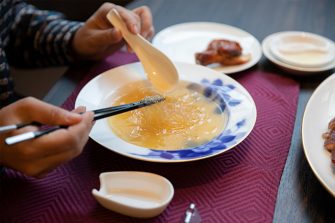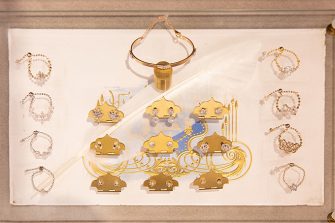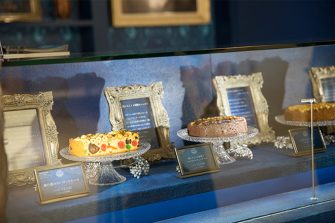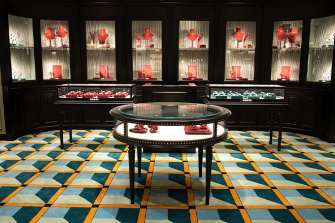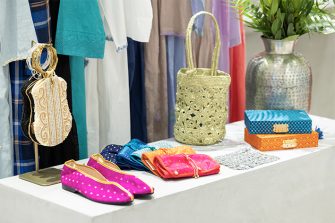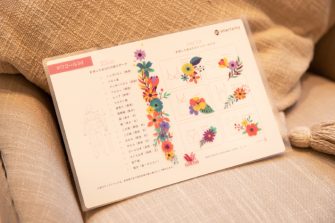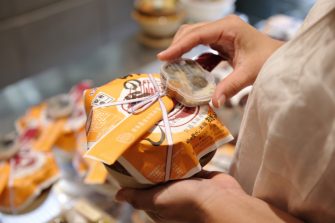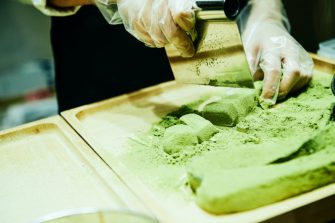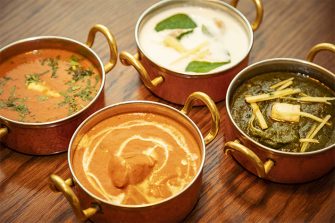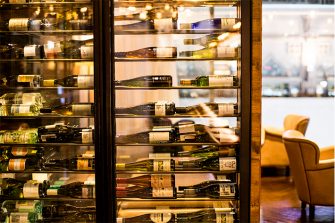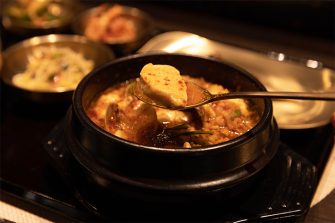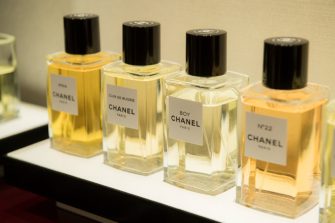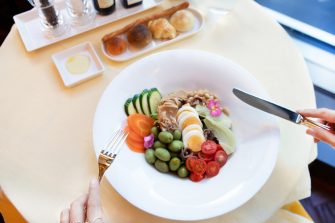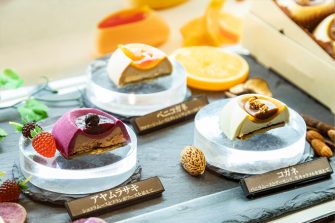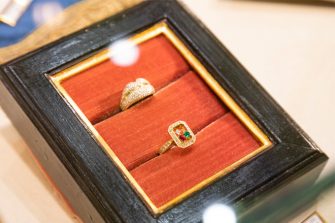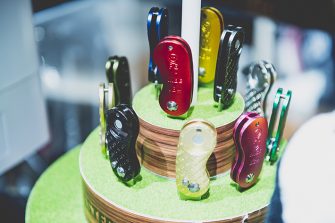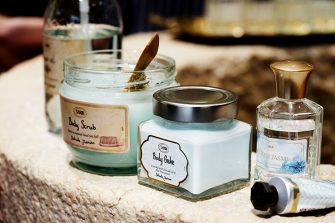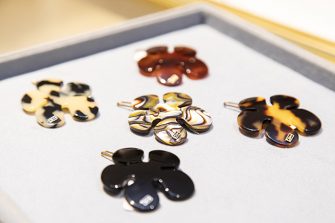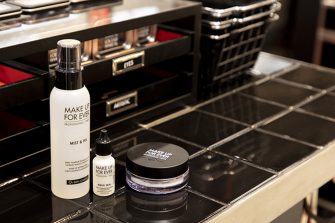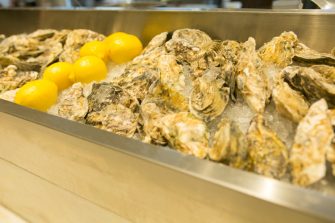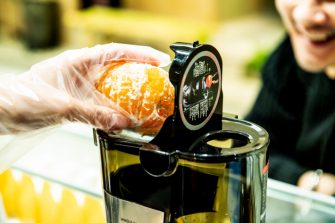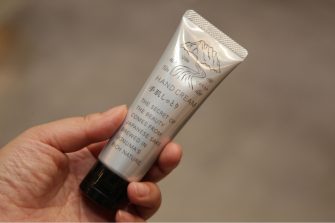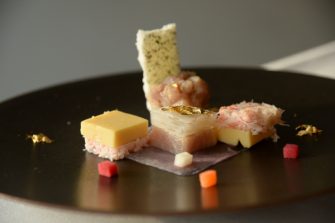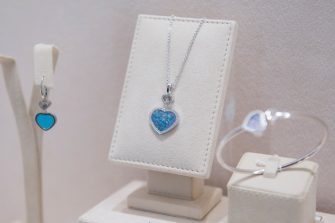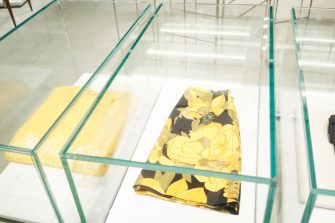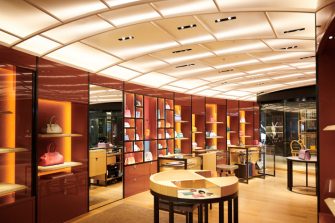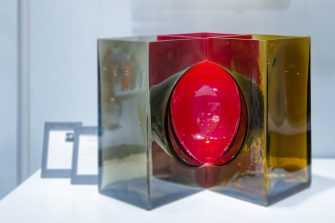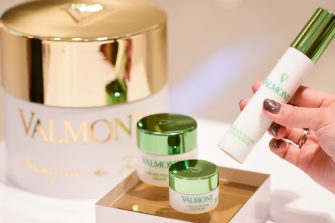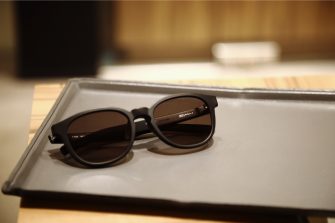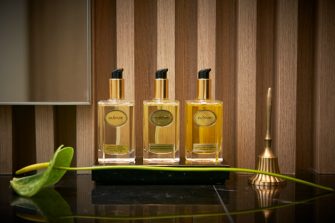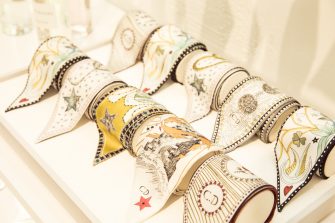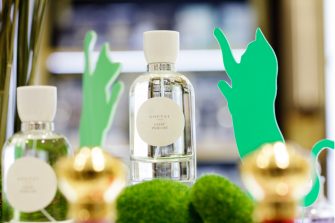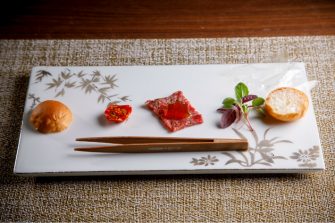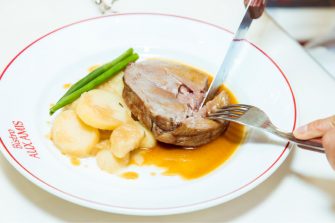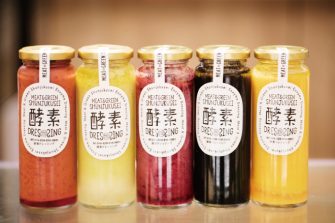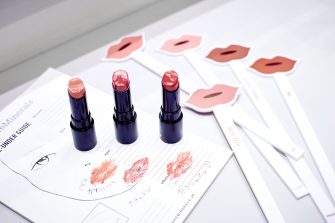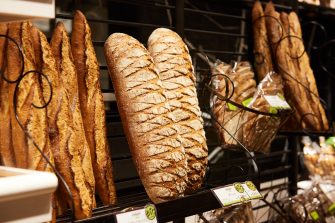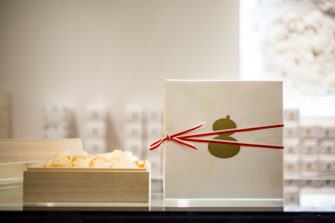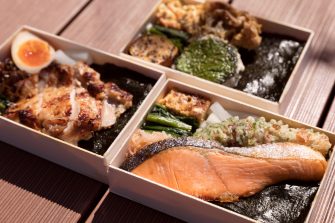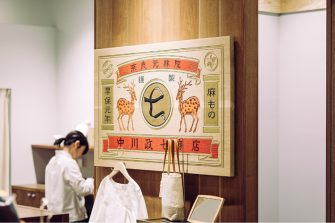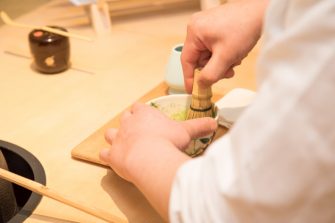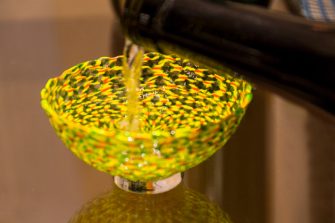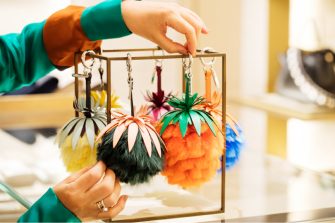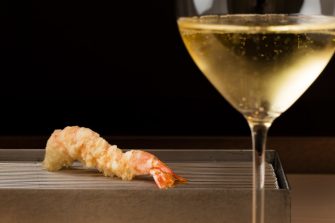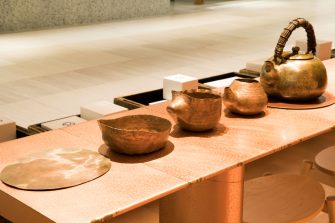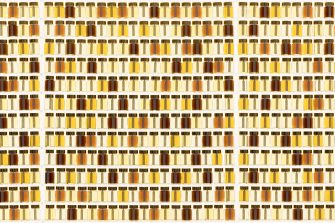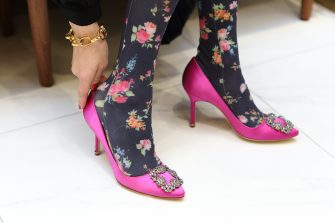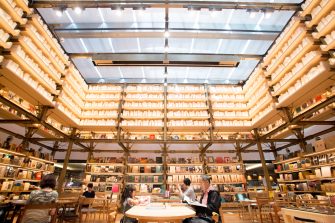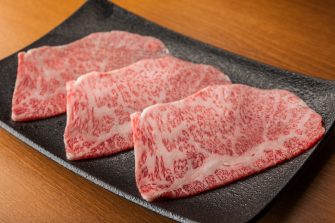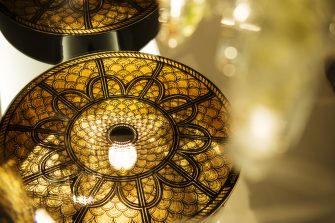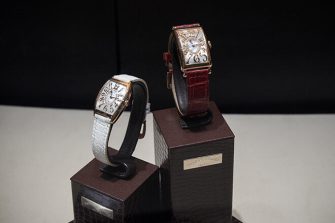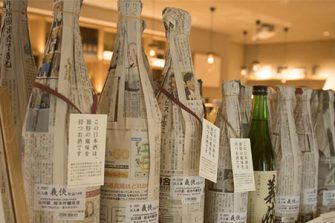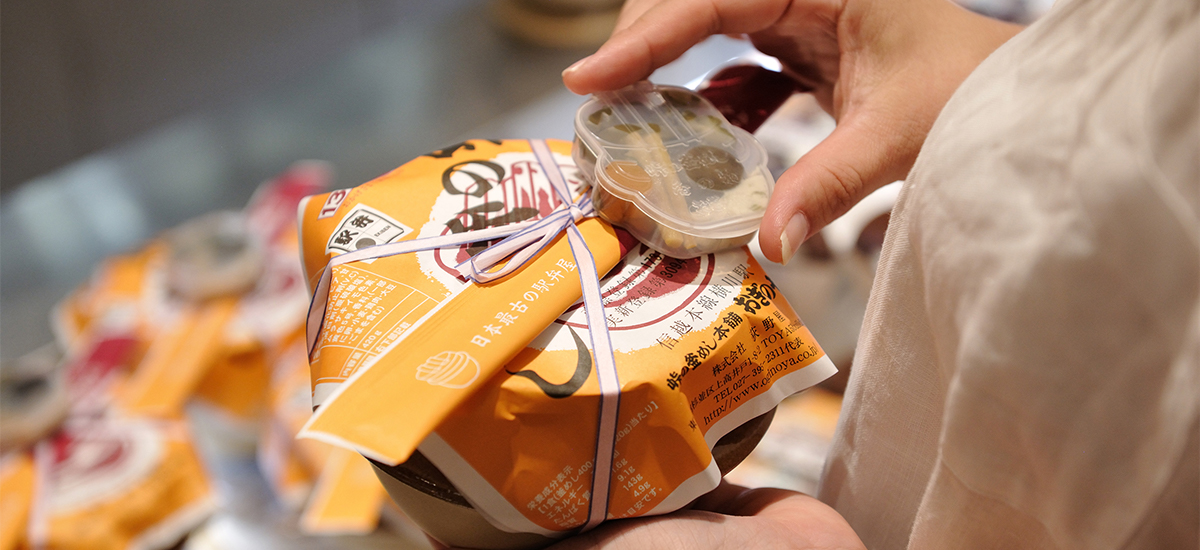

GINZA SIX EDITORS
ファッション、ジュエリー&ウォッチ、ライフスタイル、ビューティ、フード…
各ジャンルに精通する個性豊かなエディターたちが、GINZA SIXをぶらぶらと
歩いて見つけた楽しみ方を綴ります。
銀座でおいしい旅をする A Sojourn of Entrancing Flavors in Ginza
田中 美保
GINZA SIX EDITORS Vol.101
旅に出たい。おこもりの春を経て、夏らしいこともできないまま、あっという間に秋の気配。そろそろどこかに出かけたい…とソワソワしてしまうのも仕方ない。旅の醍醐味はやっぱり、その土地ならではの景色や人、味との出会いだ。とりわけ、食いしん坊の私にとって旅の目的は1にも2にも3にも「食」。そこでしか食べられないおいしいものを求めて、その土地へ行くことだってしょっちゅうなのだ。
なかなか旅ができない今、私の「旅」欲と、「食いしん坊」欲を一気に満たしてくれる場所が銀座にある。GINZA SIXのB2F。北は北海道、南は福岡県まで、全国各地のおいしいものがそろう。食いしん坊編集者としていわゆる「デパ地下」事情をいろいろ見てきたけれど、これほど心ときめくラインナップはほかにない。お弁当からスイーツ、ドリンクまで、気のきいた、かつセンスがいい手土産が買えるのはもちろん、自分のためのご褒美品、家時間が楽しくなるおいしいものがそろいすぎていて、ここに来たら決まって散財してしまう。ああ、なんて罪な場所…。
というわけで、今回は「おいしい旅」をテーマにGINZA SIXのB2Fを駆け巡った。この旅がもう、楽しすぎて! このプラン、あと6案は立てることができると断言する。
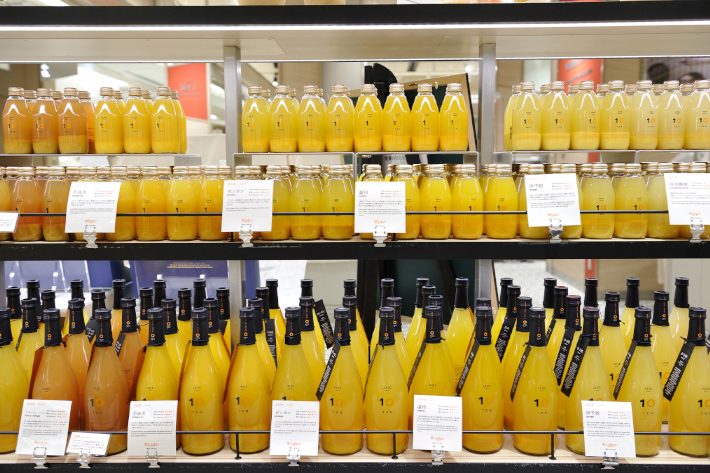
まず、最初に訪れたのは、「10FACTORY」。みかん色の美しいグラデーションに、テンション爆上がり。愛媛県・松山市に本店があるこちらは、日本一の柑橘王国・愛媛県のみかん産業をもりあげるべく誕生したブランドで、ジュースからジャム、ゼリー、ドライフルーツやはちみつなどラインナップが豊富。
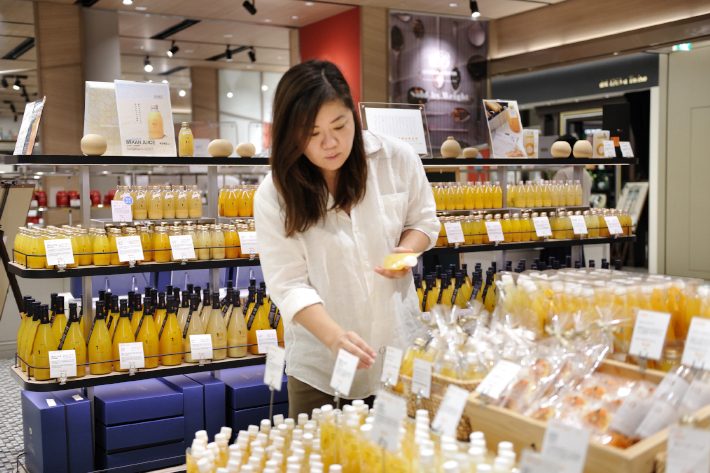
ジュースが並ぶ棚を穴があくほど見つめた後は、ゼリーコーナーへ。まるでゼリーの花が咲き乱れたようなお花畑(私にはそう見えた)にうっとり。本当は全種類、購入したいところをぐっとこらえているのが、真剣な表情からうかがえる。
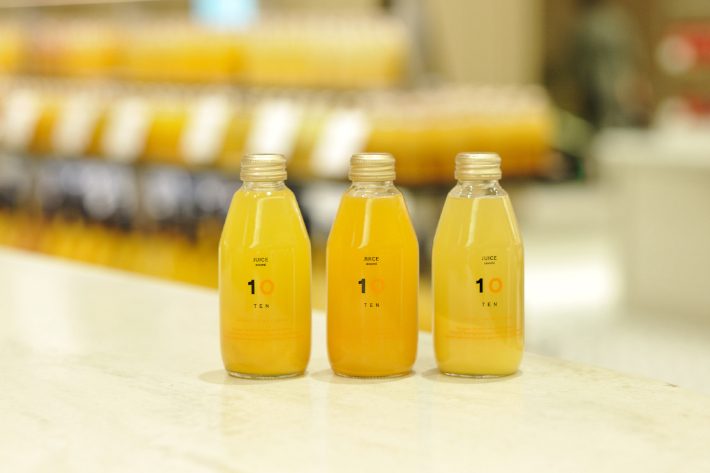
「愛媛県・松山を旅した気分になれるジュースを選ぶなら?」とスタッフの方を質問攻めにしながら選んだ3本。右から、伊予柑、甘平、果試28号。愛媛を代表する品種「伊予柑」(500円 ※以下全て税抜価格)は甘さと酸味のバランスが完璧、ザ・みかんの味。続く「甘平」(704円)は、極上の甘さが特徴。育てるのが難しく、希少な愛媛県オリジナル品種だそう。最後に飲んだ「果試28号」(704円)も愛媛県オリジナル品種。桃のような風味漂うトロピカルな甘みがたまりません! 気分はすでに愛媛なう。
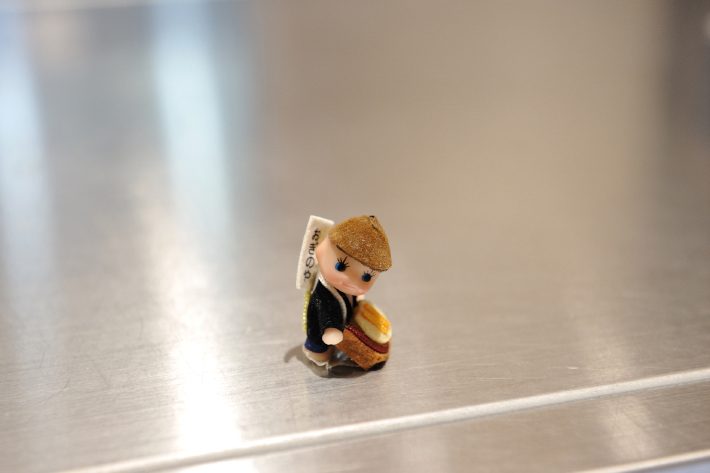
さて、旅といったら駅弁。キューピーが何か持っている…?
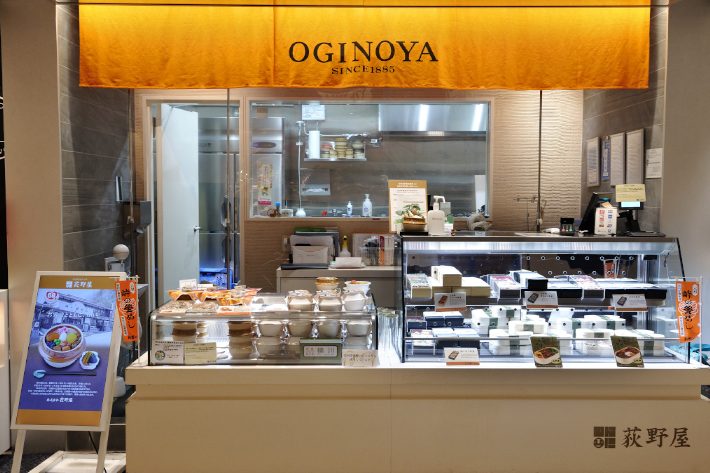
駅弁といったら「荻野屋」の「峠の釜めし」! 群馬県や長野県方面に出かけた際、見かけたらいつも条件反射で買ってしまう。(キューピーが持っていたのは「峠の釜めし」でした)
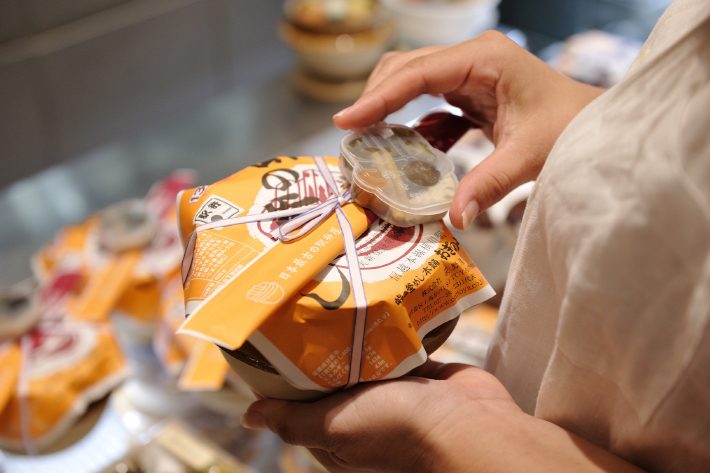
銀座という場所で、まさか「峠の釜めし」が買えるなんて…。ずっしりと重いのは、ぎっしりと入ったおかずとご飯はもちろん、容器が立派な益子焼の土鍋だから。旅の記念にと、毎回捨てずに持ち帰るため、家にはこの空き釜がたくさんある。自宅で直接火にかけて、ご飯が炊けて便利。オレンジ色の包装紙をそっとあけ、釜のふたを開けた瞬間、栗や鶏肉、うずらや杏が美しく並ぶ姿は、何度見ても高揚する。
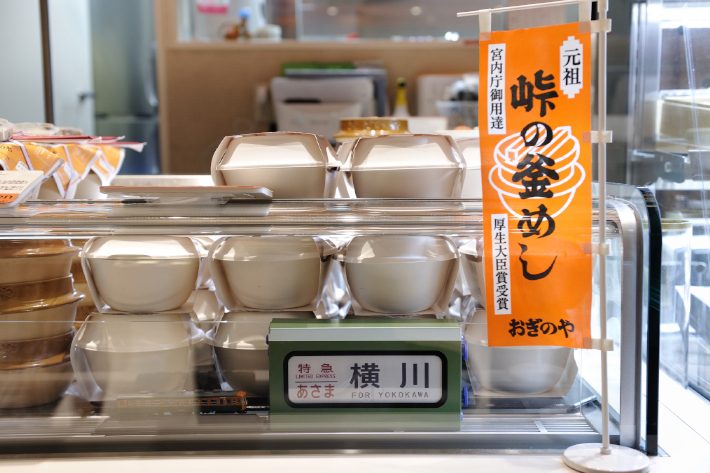
1958年、信越本線の横川駅開業と同時に誕生した名物駅弁「峠の釜めし」(1,019円)。当時、保温性が高い土鍋に入った駅弁は画期的だったとか。最近では、環境に配慮した紙の容器も登場。サトウキビのしぼりかすを使った非木材パルプ製。55年以上愛されるロングセラーも、こうやって時代とともに変化する。これぞ、老舗。
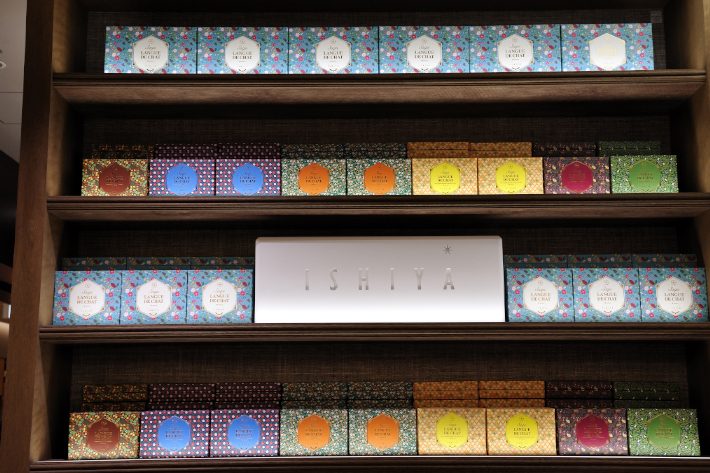
続いて旅したのは、北海道。北海道土産の定番といえば「白い恋人」ですが、こちらはその「白い恋人」でおなじみの「石屋製菓」が展開するお店、その名も「ISHIYA GINZA」。北海道を感じられるお菓子をテーマに、道外でしか買えない商品が話題に。北海道民が東京土産にこちらのお菓子をおねだりすることもあるらしく、素敵な逆輸入現象が起きているらしい。
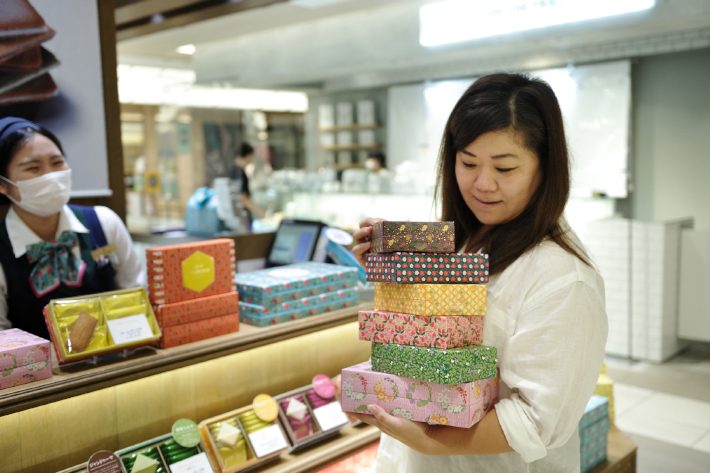
キャラメル、北海道チーズ、北海道ワインなど、北海道産の素材にこだわった6種の味わいのチョコレートを、色とりどりのラング・ド・シャでサンドした「サク」が一番人気。まさに「白い恋人」のDNAを受け継いだお菓子だが、何よりときめくのは、この美しい箱! 各フレーバーや北海道の草花がモチーフとなった柄がタイルのように敷き詰められたカラフルな箱は上品で、プレゼントにも最適。といいつつ、あまりに素敵なので自分用にと我を忘れて箱を積み上げる私。ワインと一緒に「サク」を楽しんだ後は、この箱、なんに使おうか…? もう、ワクワクがとまらない。
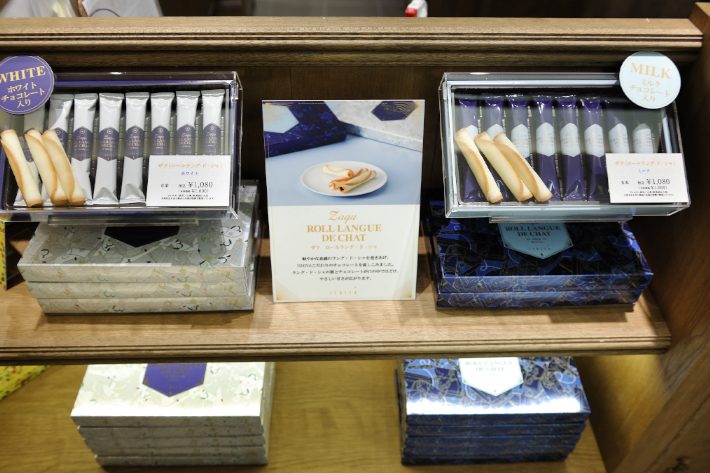
おっとここで、シルバーとブルーにきらめく箱を発見! こちらは新登場の「ザク」(1,000円)。こだわりのチョコレートを、ラング・ド・シャでくるりと巻き上げた逸品。
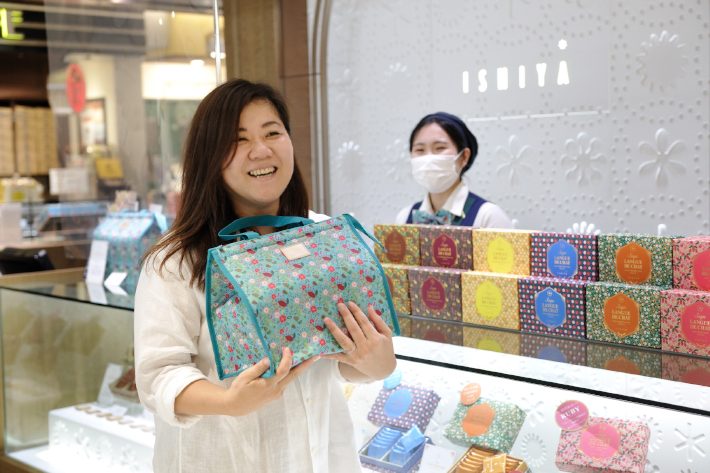
チョコレートをベストな状態で持ち運びしたい。そんな食いしん坊の願望をしかと受け止める、すばらしいアイテムが誕生。そう、保冷バッグ(700円)。6種の「サク」が入ったアソートのパッケージに使われている水色の愛らしい柄のバッグに、北海道気分満載のお菓子を詰め込んでルンルン、ご満悦のこの笑顔。ちなみにこの水色のバッグの柄は、6種それぞれのフレーバーモチーフの絵柄が入っている。
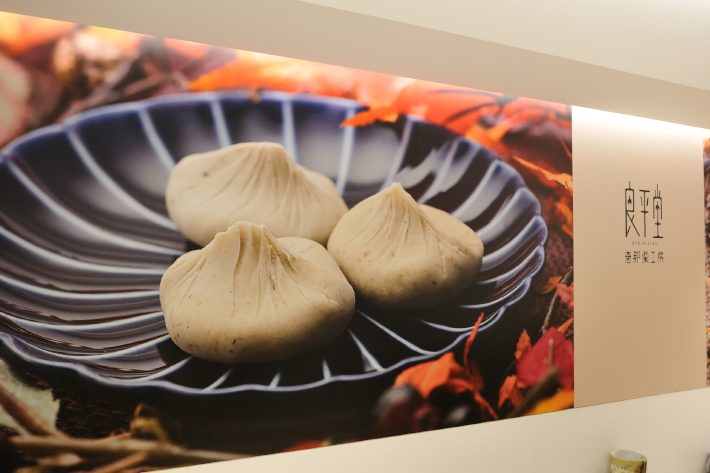
お次は、秋の味覚を味わいに岐阜県へ。ここ「恵那栗工房 良平堂」は1946年創業、岐阜県恵那市に1店舗だけある栗菓子の専門店で、2021年1月31日まで現在期間限定で出店中。ちなみに、岐阜県南東部の恵那地方(中津川市・恵那市)は栗の名産地。

ホックホクで豊かな甘みの恵那栗(えなくり)を使ったお菓子では栗きんとんが有名だが、その栗きんとんとともに代表菓子なのが「栗福餅」(390円)。鮮やかなオレンジ色の長野県・市田の干し柿の中に栗きんとんが入っていて、ねっとりホクホクの食感はクセになる。柿の皮をむいて干し、切れ目を入れて種を出して栗きんとんを詰める。そのすべてが熟練の職人による手作業だというから驚き! 2013年から伊勢神宮に奉納している銘菓とのこと。そんなエピソードとともに、目上の方や年配の方への手土産にこれ、使おう。
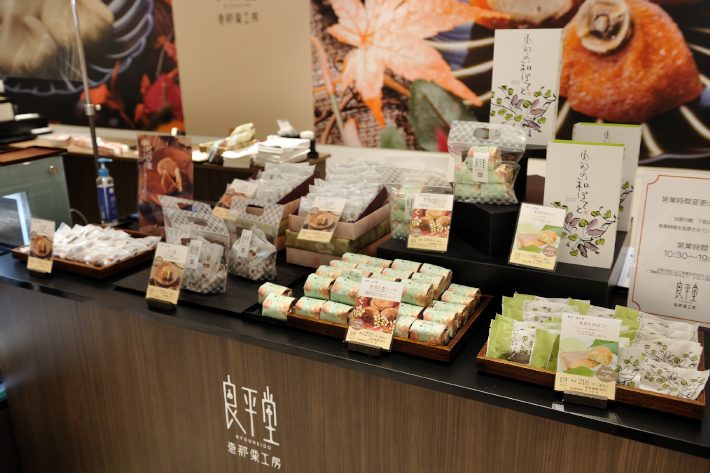
ほかにも、どこを切っても栗いっぱいの栗ようかんや栗どらやき、スイートポテトならぬ栗の和ぽてとなど、さまざまな栗のお菓子が。まさに栗をめぐる旅in岐阜。

愛媛県・松山でみかんジュース、群馬県・横川で釜めし、岐阜県・恵那で栗のお菓子、北海道・札幌でチョコレート菓子を。それぞれの土地の風土に根ざした「おいしいもの」を集めて、すっかり旅気分。
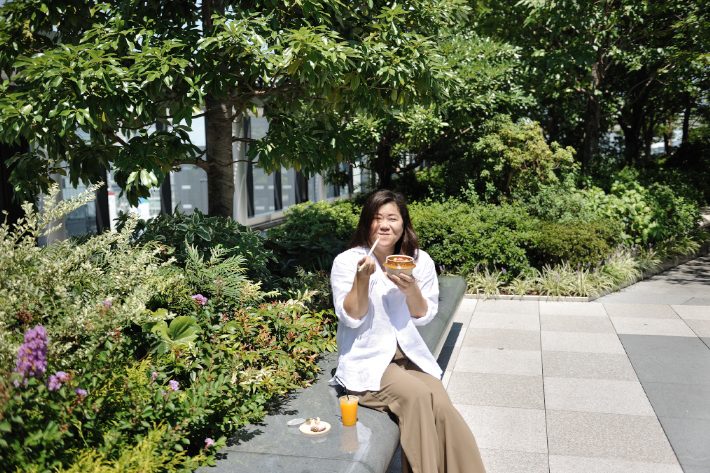
東京・銀座のど真ん中、緑豊かな屋上「GINZA SIX ガーデン」で、旅の戦利品をいただきます!
というわけで、「銀座でおいしい旅をする」の第1回(?)は無事、終了。ゆっくりじっくり、その土地の味をかみしめながら、食いしん坊の旅はまだ続く。次は、どこへ行こう?
Text: Miho Tanaka Photos: Jun Hasegawa Edit: Yuka Okada(81)
I want to travel, I want to rove. Sheltered in place all spring, I’ve seen summer come and go in the blink of an eye, with none of the usual summer things, with signs of fall now already in the air. I want to get out, I want to go somewhere—I can’t help feeling fidgety thinking about this. The pleasure of travel, of course, lies in the scenery, people, and flavors of the very place you’re visiting. I can’t get enough of good food, so when I travel, food is first, second, and third on my agenda. I look for delicious things unique to a place and head there. Normally, this is something I do fairly often.
Travel isn’t so easy now, but there’s a place that quenches my thirst for travel and desire for great food. That’s Ginza—specifically, the second belowground floor of GINZA SIX. From Hokkaido in the north to Fukuoka Prefecture in the south, there’s delicious food here from all over Japan. As the food-loving editor that I am, I’ve looked around at the various food floors in the basements of various department stores, but none offers the sparkle and appeal of the lineup at GINZA SIX. From bento to sweets and drinks to thoughtful, tasteful gifts and souvenirs—all of this is here. But you can also get a little something for yourself. There’s delicious food here—almost too much of it!—to enrich your time at home. So when I come here I spend, spend, spend. Sinful indulgences? Perhaps…
My theme today is travel with a focus on entrancing flavors. I’ve come to the second belowground floor at GINZA SIX. This trip is too much fun—but it’ll require six more to fulfill my entire agenda of gourmandise!

First up is 10FACTORY. Seeing such beautiful shades of orange sets my heart aflutter. With a flagship store located in Matsuyama, Ehime Prefecture, Japan’s No. 1 citrus producer—the Citrus Kingdom, as it’s known—this brand promotes the prefecture’s mikan industry. The store sells everything from juice to jams, jellies, dried fruit, honey, and more—a rich lineup.

After staring at the shelves of juices so hard, I head to the jelly section. It’s a field of flowers, of jelly flowers blooming their hearts out—or so it strikes me. It leaves me entranced. You can tell from the serious look on my face I’m doing my best to hold back from buying every single variety.

Peppering the sales associate with questions like, “How about a juice that makes you feel like you’re vacationing in Matsuyama in Ehime Prefecture?”, I end up choosing these three. From the left, Iyokan, Kanpei, and Kashi No. 28. Iyokan (500 yen; all prices listed before tax), a variety of mikan for which Ehime is especially well known, provides a perfect balance of sweet and tart—the definitive mikan flavor. Next is Kanpei (704 yen), the ultimate in sweetness. This variety is hard to grow and a rare variety original to Ehime Prefecture. The last one I drink is Kashi No. 28 (704 yen), also an original Ehime variety. I can’t get enough of the tropical sweetness with peach-like flavors. In my mind, I’m already in Ehime.

How can one travel in Japan without buying a bento at the train station? Can you see what Kewpie has there?

To my mind, the ultimate train station bento is Toge no Kamameshi from Oginoya. It’s something I buy reflexively whenever I head to Gunma or Nagano Prefectures. (In passing, Kewpie here is holding a Toge no Kamameshi bento.)

I can’t believe I can get a Toge no Kamameshi in Ginza. Wow—it’s heavy. It’s because so many ingredients are stuffed in there, but also because the container is an actual clay bowl fired in the famous pottery village of Mashiko. A souvenir from the trip; you won’t throw it out each time, you’ll bring it home to keep. I have a bunch of these bowls at home. They stand up to direct heat, so I use them to cook rice. Very convenient. I carefully unwrap the orange wrapping paper, remove the lid, and peer at the beautifully arranged toppings of a chestnut, chicken, a boiled quail egg, and a dried apricot. It’s uplifting no matter how many times I’ve seen it.

The famous Toge no Kamameshi (1,019 yen) train station bento was created in 1958 alongside the opening of Yokokawa Station on the Shin’etsu Main Line. At the time, a station bento provided in a clay pot, which keeps food warm exceptionally well, was revolutionary. They recently introduced environmentally-friendly paper containers made from a non-wood pulp fiber made from crushed sugarcane residue. Even a perennial best seller beloved for more than 55 years changes when the times change. This is the commendable spirit of a venerable institution like Oginoya.

The next stop on my trip is Hokkaido. Shiroi Koibito is the standard Hokkaido souvenir. It just so happens that this store is run by Ishiya Co., makers of Shiroi Koibito, the little langue de chat cookies with white chocolate. The name, too, is ISHIYA GINZA. Strangely enough, in the context of cookies and sweets that put one in a Hokkaido state of mind, products available only outside Hokkaido have emerged as a hot topic. They say Hokkaido residents often ask someone visiting Tokyo to bring back some of these Tokyo-only Hokkaido sweets—a nice example of the faux nonnative import phenomenon, perhaps.

Of the six flavors of chocolate available, all drawing on Hokkaido ingredients like caramel, Hokkaido cheese, and Hokkaido wine, Saku, sandwiched between multicolored langue de chat is the most popular. The sweets here truly inherit the DNA of Shiroi Koibito, but I’m just as inspired by the lovely boxes. Their design is based on the flavors and flowering plants of Hokkaido, with motifs arranged in tile-like patterns. They’re elegant and make great gifts… I say this, but they’re so nice I forget myself and pile them up in my arms just for me. After enjoying Saku with some wine, what should I do with the boxes? Again, I’m filled with elation just thinking about it.

Oh my, look what we have here, sparkling boxes of silver and blue. These are the new Zaku (1,000 yen). Made with premium chocolate rolled up in langue de chat—an exquisite treat.

I set myself the mission of getting this chocolate home in the best possible condition. It so happens that the perfect item to meet this particular need exists: this little cooler bag, the Horei Bag (700 yen). The bag features the same charming light blue pattern found on the Saku boxes filled with six-flavor assortments. Imagine my delight with all these sweets, all brimming with Hokkaido spirit! The light blue pattern on the bag, incidentally, incorporates each of the six motifs corresponding to the six flavors.

My journey continues. For some seasonal fall flavors, up next is Gifu Prefecture. This is Enaguri Kobo Ryoheido, a chestnut confectionary specialist founded in 1946 as a single storefront in Ena, Gifu Prefecture. The location here will be in GINZA SIX for a limited time, until January 31, 2021. In case you were wondering, the Ena region of southeastern Gifu Prefecture (the cities of Nakatsugawa and Ena) is renowned for its chestnuts.

Richly flavored sweets made with sweet Ena chestnuts include the famous kuri kinton (candied chestnuts). Another famous chestnut confection is Kuri Fukumochi (390 yen), comprising kuri kinton stuffed in a vibrant orange-colored persimmon, peeled, dried, and cut open to remove the seeds, from Ichida in Nagano Prefecture. The autumnal textures of sticky persimmon and soft, flaky chestnut are positively addictive. It’s a bit of a surprise to learn everything is done by hand by skilled confection makers. I’m told these famous chestnut confections have been bestowed as offerings at Ise Jingu shrine since 2013. I’ll be sure to relate this story when I give them as gifts to my superiors or those senior to me.

The store also has chestnut yokan (sweet chestnut paste jelly) and chestnut dorayaki (pancake sandwiched with sweet chestnut paste). Cut into one and you will find chestnuts. Plus there are also Japanese-style baked sweet chestnut cakes—a huge variety of chestnut confections. Truly a chestnut-filled trip in Gifu.

With my mikan juice from Matsuyama, Ehime Prefecture, kamameshi from Yokokawa, Gunma Prefecture, chestnut confections from Ena, Gifu Prefecture, chocolate confections from Sapporo, Hokkaido, I’m all set. I’ve assembled delicious fare from the local land and culture. I can now say I’ve well-travelled.

Here I am, enjoying the spoils of my travel at GINZA SIX Garden on the rooftop, a sanctuary of green in the middle of Ginza, Tokyo.
And so my first (?) sojourn of entrancing flavors in ginza comes to a happy conclusion. I’ve leisurely partaken of the flavors of each locality to my heart’s content. But this food-lover’s travels are far from over. Where next?
Text: Miho Tanaka Photos: Jun Hasegawa Edit: Yuka Okada(81)
田中 美保
「Precious」「和樂」「Domani」で、旅、食、インテリアといったライフスタイル特集やカルチャーページ、インタビュー記事などを編集・執筆。阿川佐和子著「看る力」ほか、レシピ本や生き方本の書籍も担当。おいしいものへの執念はすさまじく、食いしん坊エディターとしても活躍。


